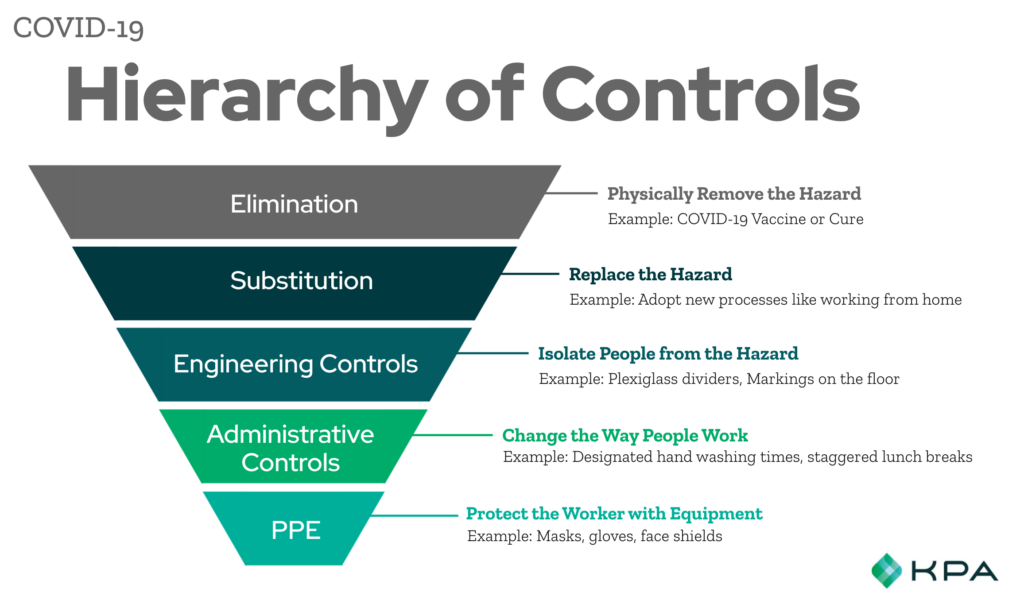It’s the simple, powerful, time-tested tool that could save you from the apocalypse.
No, I’m not talking about a shotgun or a flamethrower. I’m referring to the hazard control prevention system called the hierarchy of controls.
A hierarchy of controls is an approach to environmental safety (whether that environment is your workplace or home) that structures protective measures into 5 stages, in order of most to least effective:
1. Elimination
2. Substitution
3. Engineering Controls
4. Administrative Controls
5. Personal Protective Equipment
Read the in-depth article: The Hierarchy of Controls: What It Is and How to Use It

Think of these stages as lines of defense.
The first one, elimination, is the best possible defense—you eradicate or remove the hazard from the environment.
On the other end of the hierarchy, we have PPE: the last resort. If you can’t get rid of the problem, swap it for something else, or engineer or govern it away, the only option you have left is to suit up and protect yourself.
As far as safety standards go, the hierarchy of controls method is more or less universal—because it works. It can be adapted to mitigate any risk in any crisis, from a chemical leak to a zombie outbreak.
Right now, as the world suffers through the COVID-19 pandemic—perhaps the worst health crisis of our lifetimes—the hierarchy of controls is the world’s risk management roadmap. It’s the system hospitals, governments, and organizations of all kinds (whether they’re “essential” businesses or not) are using to minimize infection and protect people.
At the current stage of this crisis, elimination isn’t an option. There’s no COVID-19 cure or vaccine available, not yet.
Substitution means replacing the material (the hazardous thing) or the process (the hazardous way of operating) with something else—something non-hazardous or less hazardous. We can’t replace COVID-19, so we have to reduce the rate of transmission by adopting new processes. For many organizations, that means limiting exposure by going virtual and having employees work from home.
But not every organization can operate remotely. Those that can’t are moving to #3 and using engineering controls to protect workers: tape on the floor to keep people at least 6 feet apart, partitions in reception and point-of-sale areas, contactless payments, and so forth.
If engineering controls aren’t viable, then it’s time to use administrative controls. These are at the core of the CDC’s recommendations: ensure at least 6 feet of social distancing, wash hands regularly, wipe down shared surfaces often. Many organizations have instituted designated hand-washing times, where employees are instructed to take a trip to the restroom and wash their hands every 90 minutes.
Finally, where the other controls aren’t enough, there’s personal protective equipment (PPE), PPE includes masks, gloves, face shields, hazmat suits, and the like.
As the hierarchy of controls method illustrates, PPE is really the least desirable and least effective way to handle COVID-19. It’s necessary—and it can certainly save lives—but it shouldn’t be the only strategy if and when there are other options. Elimination, substitution, and engineering and administrative controls are all better strategies. And the best risk management strategies have all 5 levels of control in place.
So, as long as COVID-19 remains a threat, employers need to do the following:
1. Isolate employees and have them work from home.
2. If employees can’t work from home, make sure they keep a safe working distance from each other, customers, and other people.
3. Ensure employees wash their hands and sanitize surfaces frequently.
4. Keep up-to-date with your federal and local authorities’ guidelines, and follow those guidelines consistently.
5. Have functioning, suitable PPE available, and ensure people wear masks, gloves, and/or other equipment when necessary.
Onerous as it is, the hierarchy of controls the best defense we have against this virus—or any crisis, for that matter. No, it’s not as badass as a flamethrower, but it’s a whole lot more effective.
Discover how EHS software will help your organization in a post-COVID-19 world, and for more COVID-19 safety guidance, visit KPA’s Coronavirus Resource Center.

